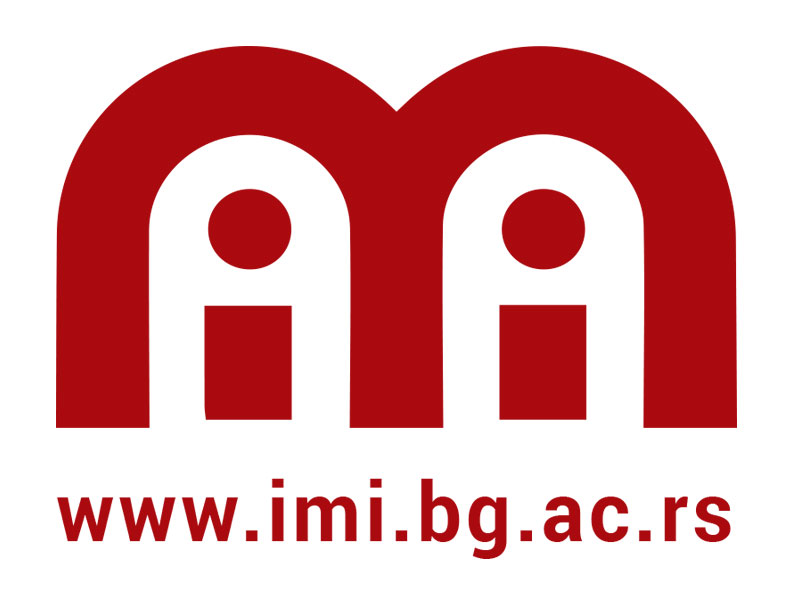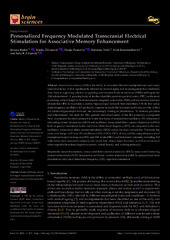Personalized Frequency Modulated Transcranial Electrical Stimulation for Associative Memory Enhancement
Аутори
Bjekić, Jovana
Živanović, Marko

Paunović, Dunja

Vulić, Katarina

Konstantinović, Uroš

Filipović, Saša

Чланак у часопису (Објављена верзија)
Метаподаци
Приказ свих података о документуАпстракт
Associative memory (AM) is the ability to remember the relationship between previously unrelated items. AM is significantly affected by normal aging and neurodegenerative conditions, thus there is a growing interest in applying non-invasive brain stimulation (NIBS) techniques for AM enhancement. A growing body of studies identifies posterior parietal cortex (PPC) as the most promising cortical target for both transcranial magnetic stimulation (TMS) and transcranial electrical stimulation (tES) to modulate a cortico-hippocampal network that underlines AM. In that sense, theta frequency oscillatory tES protocols, targeted towards the hallmark oscillatory activity within the cortico-hippocampal network, are increasingly coming to prominence. To increase precision and effectiveness, the need for EEG guided individualization of the tES protocols is proposed. Here, we present the study protocol in which two types of personalized oscillatory tES–transcranial alternating current stimulation (t...ACS) and oscillatory transcranial direct current stimulation (otDCS), both frequency-modulated to the individual theta-band frequency (ITF), are compared to the non-oscillatory transcranial direct current stimulation (tDCS) and to the sham stimulation. The study has cross-over design with four tES conditions (tACS, otDCS, tDCS, sham), and the comprehensive set of neurophysiological (resting state EEG and AM-evoked EEG) and behavioral outcomes, including AM tasks (short-term associative memory, face–word, face–object, object-location), as well as measures of other cognitive functions (cognitive control, verbal fluency, and working memory).
Кључне речи:
associative memory / cognitive assessment / EEG / individual theta-band frequency / personalized brain stimulation / transcranial alternating current stimulation (tACS) / transcranial direct current stimulation (tDCS) / transcranial oscillatory current stimulation (otDCS)Извор:
Brain Sciences, 2022, 12, 4, 472-Финансирање / пројекти:
- MEMORYST - From Brain Waves to Memory Boost: Memory Enhancement By Personalized Frequency-Modulated Noninvasive Brain Stimulation (RS-ScienceFundRS-Promis-6058808)
- Министарство науке, технолошког развоја и иновација Републике Србије, институционално финансирање - 200015 (Универзитет у Београду, Институт за медицинска истраживања) (RS-MESTD-inst-2020-200015)
- Министарство науке, технолошког развоја и иновација Републике Србије, институционално финансирање - 200163 (Универзитет у Београду, Филозофски факултет) (RS-MESTD-inst-2020-200163)
Институција/група
Institut za medicinska istraživanjaTY - JOUR AU - Bjekić, Jovana AU - Živanović, Marko AU - Paunović, Dunja AU - Vulić, Katarina AU - Konstantinović, Uroš AU - Filipović, Saša PY - 2022 UR - http://rimi.imi.bg.ac.rs/handle/123456789/1230 AB - Associative memory (AM) is the ability to remember the relationship between previously unrelated items. AM is significantly affected by normal aging and neurodegenerative conditions, thus there is a growing interest in applying non-invasive brain stimulation (NIBS) techniques for AM enhancement. A growing body of studies identifies posterior parietal cortex (PPC) as the most promising cortical target for both transcranial magnetic stimulation (TMS) and transcranial electrical stimulation (tES) to modulate a cortico-hippocampal network that underlines AM. In that sense, theta frequency oscillatory tES protocols, targeted towards the hallmark oscillatory activity within the cortico-hippocampal network, are increasingly coming to prominence. To increase precision and effectiveness, the need for EEG guided individualization of the tES protocols is proposed. Here, we present the study protocol in which two types of personalized oscillatory tES–transcranial alternating current stimulation (tACS) and oscillatory transcranial direct current stimulation (otDCS), both frequency-modulated to the individual theta-band frequency (ITF), are compared to the non-oscillatory transcranial direct current stimulation (tDCS) and to the sham stimulation. The study has cross-over design with four tES conditions (tACS, otDCS, tDCS, sham), and the comprehensive set of neurophysiological (resting state EEG and AM-evoked EEG) and behavioral outcomes, including AM tasks (short-term associative memory, face–word, face–object, object-location), as well as measures of other cognitive functions (cognitive control, verbal fluency, and working memory). T2 - Brain Sciences T1 - Personalized Frequency Modulated Transcranial Electrical Stimulation for Associative Memory Enhancement IS - 4 SP - 472 VL - 12 DO - 10.3390/brainsci12040472 ER -
@article{
author = "Bjekić, Jovana and Živanović, Marko and Paunović, Dunja and Vulić, Katarina and Konstantinović, Uroš and Filipović, Saša",
year = "2022",
abstract = "Associative memory (AM) is the ability to remember the relationship between previously unrelated items. AM is significantly affected by normal aging and neurodegenerative conditions, thus there is a growing interest in applying non-invasive brain stimulation (NIBS) techniques for AM enhancement. A growing body of studies identifies posterior parietal cortex (PPC) as the most promising cortical target for both transcranial magnetic stimulation (TMS) and transcranial electrical stimulation (tES) to modulate a cortico-hippocampal network that underlines AM. In that sense, theta frequency oscillatory tES protocols, targeted towards the hallmark oscillatory activity within the cortico-hippocampal network, are increasingly coming to prominence. To increase precision and effectiveness, the need for EEG guided individualization of the tES protocols is proposed. Here, we present the study protocol in which two types of personalized oscillatory tES–transcranial alternating current stimulation (tACS) and oscillatory transcranial direct current stimulation (otDCS), both frequency-modulated to the individual theta-band frequency (ITF), are compared to the non-oscillatory transcranial direct current stimulation (tDCS) and to the sham stimulation. The study has cross-over design with four tES conditions (tACS, otDCS, tDCS, sham), and the comprehensive set of neurophysiological (resting state EEG and AM-evoked EEG) and behavioral outcomes, including AM tasks (short-term associative memory, face–word, face–object, object-location), as well as measures of other cognitive functions (cognitive control, verbal fluency, and working memory).",
journal = "Brain Sciences",
title = "Personalized Frequency Modulated Transcranial Electrical Stimulation for Associative Memory Enhancement",
number = "4",
pages = "472",
volume = "12",
doi = "10.3390/brainsci12040472"
}
Bjekić, J., Živanović, M., Paunović, D., Vulić, K., Konstantinović, U.,& Filipović, S.. (2022). Personalized Frequency Modulated Transcranial Electrical Stimulation for Associative Memory Enhancement. in Brain Sciences, 12(4), 472. https://doi.org/10.3390/brainsci12040472
Bjekić J, Živanović M, Paunović D, Vulić K, Konstantinović U, Filipović S. Personalized Frequency Modulated Transcranial Electrical Stimulation for Associative Memory Enhancement. in Brain Sciences. 2022;12(4):472. doi:10.3390/brainsci12040472 .
Bjekić, Jovana, Živanović, Marko, Paunović, Dunja, Vulić, Katarina, Konstantinović, Uroš, Filipović, Saša, "Personalized Frequency Modulated Transcranial Electrical Stimulation for Associative Memory Enhancement" in Brain Sciences, 12, no. 4 (2022):472, https://doi.org/10.3390/brainsci12040472 . .
Related items
Showing items related by title, author, creator and subject.
-
Evidence-based guidelines on the therapeutic use of repetitive transcranial magnetic stimulation (rTMS): An update (2014-2018)
Lefaucheur, Jean-Pascal; Aleman, Andre; Baeken, Chris; Benninger, David H.; Brunelin, Jerome; Di Lazzaro, Vincenzo; Filipović, Saša; Grefkes, Christian; Hasan, Alkomiet; Hummel, Friedhelm C.; Jaaskelainen, Satu K.; Langguth, Berthold; Leocani, Letizia; Londero, Alain; Nardone, Raffaele; Nguyen, Jean-Paul; Nyffeler, Thomas; Oliveira-Maia, Albino J.; Oliviero, Antonio; Padberg, Frank; Palm, Ulrich; Paulus, Walter; Poulet, Emmanuel; Quartarone, Angelo; Rachid, Fady; Rektorova, Irena; Rossi, Simone; Sahlsten, Hanna; Schecklmann, Martin; Szekely, David; Ziemann, Ulf (Elsevier Ireland Ltd, Clare, 2020) -
Improvement of language functions in a chronic non-fluent post-stroke aphasic patient following bilateral sequential theta burst magnetic stimulation
Vuksanović, Jasmina; Jelić, Milan; Milanović, Slađan; Kacar, Katarina; Konstantinović, Ljubica; Filipović, Saša (Routledge Journals, Taylor & Francis Ltd, Abingdon, 2015) -
Changes in cortical excitability during paired associative stimulation in Parkinson's disease patients and healthy subjects
Kačar, Aleksandra; Milanović, Slađan; Filipović, Saša; Ljubisavljević, Miloš (Elsevier Ireland Ltd, Clare, 2017)


